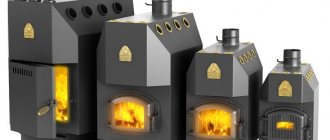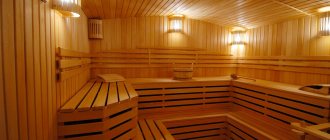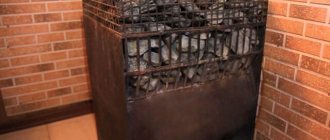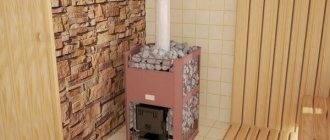Cold in a bathhouse is a necessary and useful thing, if of course it is in the form of a tub of ice water or a bucket of snow, in any other case it is a real disaster. It should be noted that this trouble is not the rarest one that lovers of brooms and steam have to face.
Not a high temperature in a steam room is common; many of us are generally supporters of a warm bath, but, as they say, everything should be in moderation. When, after throwing water on, there is no smell of steam, or it immediately evaporates, or your feet freeze on the floor, then this is no longer the case.
Let's try to figure out what are the reasons for this phenomenon and whether it is possible to do something.
Insulating a steam room in a bathhouse: reasons and rules
High-quality thermal insulation of a wooden bathhouse is necessary if, for example, you would like to use the building during cold periods of the year, when frost sets in.
In addition, insulation of the steam room is required if the heat emanating from the stove does not warm the room properly enough. In this case, the bath takes a very long time to warm up to the required temperature, and then cools down quite quickly, and the steam room is not able to provide the relative quality of the procedure. The longer the steam room holds heat and the slower it cools, the higher its quality is considered. Among other things, the main reasons for thermal insulation are to ensure that, by maintaining an optimal temperature in the steam room, the walls of the building are protected from high humidity, vapors and condensation. The impact of such factors, as a result, leads to the destruction of walls. The walls of the log house at sub-zero temperatures will freeze, the condensed moisture will freeze, burst the material of the structure, form dampness and fungi, mold, then rot and destruction occurs.
There is no need to skimp when selecting materials. By saving, for example, on a vapor barrier layer, we get the inevitable appearance of mold on the surface of the walls, and as a result, rotting of wood finishing elements. Thermal insulation materials must be resistant to the high temperatures inherent in the steam room. A rolled basalt product is suitable, and for vapor barrier protection, it is more reliable to use aluminum foil.
Of course, even when building a log bathhouse, it was necessary to take care of proper insulation. Gaps and cracks in the walls must be carefully caulked. For such purposes, moss was previously pulled up, dried and used as pads placed between logs. In modern times, natural and natural materials are also used as inter-crown insulation.
Before starting installation work on thermal insulation, you need to prepare the surfaces of the walls. Carefully inspect the base for the presence of mold and mildew, protrusions on the surface and foreign inclusions. If there is fungus on the wood material, it is eliminated by spraying the surface with an antiseptic specifically designed for rooms with high humidity.
The insulation of a steam room takes place using a technology that involves a kind of “sandwich” of materials consisting of several layers, such as a waterproofing layer, insulation, a vapor barrier layer and the internal lining of the room. Experienced bath architects say that the thermal insulation of a steam room in a bathhouse must be thorough, so a fairly significant layer about 15 centimeters thick is required. Therefore, below we will discuss each of the layers of the “sandwich” in detail.
Poor ventilation
Let’s say you are completely confident in the performance of your stove, but it’s cold in the bathhouse! In this case, let's pay attention to ventilation. In the old days, when they didn’t know what insulation, double-glazed windows or self-leveling floors were, no one thought about ventilation, the air itself seeped in and also went out through the ceiling powder. And the space of a village bathhouse was not divided into two or more rooms. Now everything is different, which requires a modern approach.
Separation of zones with careful insulation of each of them is simply impossible without properly arranged ventilation, otherwise the air will just stand - cold at the bottom, hot at the top. Our task is to make it circulate, thereby distributing the heat where we need it.
This is usually done like this: a small window is installed in the partition of the steam room with the washing room; it connects two closed rooms. In the washing room, usually near the stove, a ventilation hole is made, which is led through the floor into the steam room through a channel or corrugation. The system arranged in this way works as follows: heated air from the stones enters the room, and is replaced by cold air through the lower hole into the steam room.
It became warm in the washing room or they went to take a steam bath - the top window was closed.
This system can be modified and linked to a leaking floor, but more on that below.
Insulation of bath walls from outside
It is best to insulate the walls of a bathhouse from the outside, this is already a proven fact. This way you save the usable area of the building, and you don’t have many problems that can arise with internal wall insulation. Among other things, external insulation allows you to isolate the walls of the building from the external influence of the atmosphere, which undoubtedly extends the life of the building.
Since in most cases the bathhouse is built of wood, in this article we will look at the stages of insulation of just such a building.
The first stage of wall insulation is sealing the cracks between logs or beams. You need to caulk the timber with a special material, usually it is either sphagnum moss, tow or jute for caulking. The process itself is not complicated but labor-intensive; essentially, you need to insert the insulation into the resulting gap between the wooden structural elements.
The next stage is the installation of wooden sheathing; you first need to treat the wooden elements of the wall and the sheathing with a special antiseptic impregnation; this will greatly extend the life of your building and protect it from moisture and various pests.
A waterproofing film is also placed under the sheathing, which will protect your walls from moisture. The sheathing is attached to the walls of the bathhouse using wood screws or special fasteners.
Insulation is placed between the sheathing; it can be either polystyrene foam or mineral wool. The distance between the lathing should be selected in relation to the width of the insulation. You can fasten the insulation in different ways; some use nails, others use staples or screws. The work is not difficult and, in principle, you can do it yourself, the main thing here is that the sheathing is correctly positioned, then the work with the insulation will go quickly. We attach a windproof film on top of the insulation, which will protect our structure from moisture and wind.
Now you need to secure the finishing material. On sale you will find many different materials for the facade. In most cases, the cheapest option is to use siding. Some use a timber simulator, or façade cassettes.
Eucalyptus infusion
Pour boiling water over crushed eucalyptus leaves. Let it sit for about 20 minutes. Strain and dilute in two liters of warm water. To prepare such an infusion, 1 tablespoon of raw material per glass of water is enough.
Eucalyptus is a storehouse of nutrients. Inhalations with eucalyptus are real herbal medicine. Its aroma relieves tension and headaches, treats old coughs and runny nose. Eucalyptus is an indispensable assistant in the treatment of bronchi, larynx, and lungs. If you don’t want to breathe this infusion, then just try steaming with a eucalyptus broom - the result will be no worse.
The first layers of the “sandwich”: waterproofing and insulation
The technology for thermal insulation of steam room walls involves starting work with the waterproofing layer. Due to the fact that external walls, coming into contact with heated air emanating from the interior, can condense moisture, which leads to fungus and rotting of wood.
To waterproof the surface, you can use polyethylene film or foil. It is not recommended to use roofing felt and glassine for such purposes.
The process of insulating a steam room in a bathhouse is not limited to the walls; you should start from the ceiling, since, paradoxically, it is due to poor thermal insulation of the ceiling that most of the heat is lost. The ceiling requires more careful thermal insulation, in which the layer of material used doubles in thickness, compared with similar work on the walls.
The material that we will use as an insulating layer must be selected according to the expected operating conditions. Since the temperature in the steam room can exceed one hundred degrees, it is therefore recommended to give preference to inorganic insulation materials. Such materials are quite durable, do not have increased water absorption, and are fire resistant.
The installation of the insulation layer is carried out after clean rolled unpainted paper has been secured to the walls on top of the waterproofing layer. The use of a clean paper layer reduces the loss of hot air in the room and also prevents the release of harmful substances into the air. Sheets or rolled pieces of paper are attached to the walls quite carefully, observing large overlaps.
Next, we attach a frame made of wooden beams with a cross-section of 50x50 mm to the wall surface. It is recommended to soak the bars with an antiseptic before installation work. The frame is made according to the width of the rolled insulation material, so that there is no additional work in cutting insulation mats to width. In addition, the consumption of insulation material is significantly saved.
Thyme infusion
For colds, it is very useful to breathe in an infusion of thyme; it is one of the most fragrant herbs! Thyme infusion and essential oil treats coughs and sore throats.
In order to get rid of dandruff, you need to wash your hair with thyme infusion. Do you want to get rid of bad breath? Rinse your mouth with the infusion of this herb.
In the summer, the entire green pharmacy is located next to us. But in winter, retail trade will help us. Each bath department sells bottles with various bath infusions. A choice for every taste!
To create a unique aroma, just a few drops of tincture on a ladle of water are enough. After all, the infusion is a concentrate and you only need to add a little bit of it. On average, the ratio is as follows: one milliliter of infusion is taken per liter of water.
Insulation of bath walls from the inside
Although insulating a building from the inside is less practical, it is also often used when insulating buildings. The disadvantage of such insulation is obvious: you lose the usable area of the building, and problems also arise with the locations of sockets and switches.
— waterproofing film;
- lathing;
— insulation;
- another layer of film;
- finishing material;
As you can see, such insulation is not much different from external insulation. The only more striking difference can be considered the use of various finishing materials. After all, no one uses siding indoors. As for the finishing of the walls of the bathhouse, materials made from natural wood are more applicable here. Either a wooden lining or a timber simulator will look especially beautiful here.
Facts about water
Even a poor student will say that water boils at 100 degrees Celsius and freezes at zero. Only few people think about the canons of physics, according to which water should boil at minus 80 degrees, and freeze at minus 180 degrees!
This substance is not simple, oh, not simple!!!
Water is the only substance in the world that, contrary to the laws of nature, is somehow lighter in the solid state than in the liquid state. Now, if you take an iron nail and throw it into a stream of hot iron, the nail will sink. And this is how any substance on our planet will behave (solid is heavier than liquid), except water.
In water, in general, everything is exactly the opposite: tiny pieces of ice and huge icebergs float back and forth and do not sink at all...
In addition, it has already been proven that water has memory and reacts to positive and negative things. Experiments have shown that water charged with positive information, when frozen, produced crystals of amazing beauty. But if the water was charged with aggression, cruelty and other negativity, the crystals turned out shapeless and ugly.











